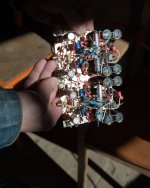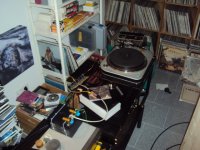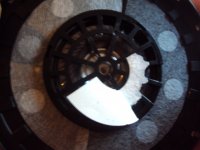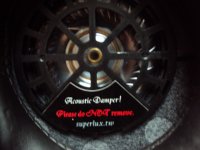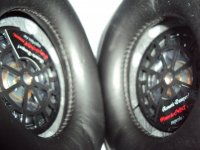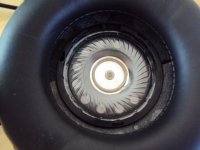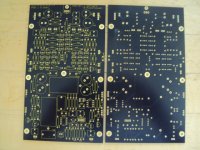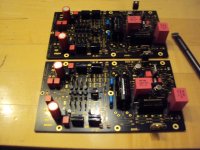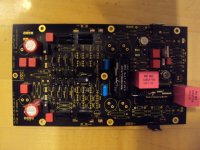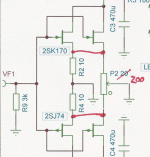I have being thinking how we could use circuit 2537. A means has to be found to invert one output and then put the two together again. With a differential opamp that can be done quite easy or with a full INA topology. I am thinking about a discrete solution but so far i came only to a hybrid schematic. More thought has to be put into this but i am dedicated to make it use full somehow.
On a sideline i am into retro mood. See the circuit and a picture of the MPP FF2010. That was the state of affairs over 1 Year ago. Have i made progress since ?
On a sideline i am into retro mood. See the circuit and a picture of the MPP FF2010. That was the state of affairs over 1 Year ago. Have i made progress since ?
Attachments
Thinking about the CCS ( complementary compound stage ) something like this could be a starting point. The gain of the input stage is set by the cartridge impedance times R1 plus R2. The RIAA could somehow being realized in the INA stage.
Attachments
I found this interesting for shielding :
EP&T - Electronic Products and Technology - Embedded capacitance material reduces impedance, power bus noise, EMI
EP&T - Electronic Products and Technology - Embedded capacitance material reduces impedance, power bus noise, EMI
After my little tutorial on parallel symmetric design i went back to the MPP Summer 2011 1.
I think this circuit deserves a PCB and also to be build and listened too. Maybe i can persuade Jan Didden to do the layout or somebody else from here can do it. I put now most of the component values and types into the circuit. The Fets that provide constant current to the Leds can also be substituted with resistors as long as 1 - 4mA flow in the Leds without much disadvantage. I have drawn only one Fet and Led per type but actually 4 of each are needed. I have not dimensioned the Gyrators. That can be a simple BJT cap multiplier like the one used by B.Vogel ( it works well, i tried it ), a Fet multiplier JC style, an Opamp multiplier, a mixture or simply an RC combination that can sound good too. The circuit could even be supplied from the DC direct because the mirrors have excellent PSU rejection.
Well done Mr. Gerhard! Two J-fets per type and one BJT per type is an optimum solution. Six db better than AD 797 is enaugh. That means also 6db better noise than Parasound JC-3 which has IC at the MC/MM input, and which got a few rave reviews. I am going to build both topology two stage versions, in a modular manner, so i may change second stage with LF eq. of which I have a few. I already have all the components which i am going to put ona a glass-fibre perfoboard.
PCB will be better solution for less capable solderers,
I wish to know current consuption of preamps in order to choose PS regulators. I prefer Borbely All fet regulators which are outstanding.
BTW, which are headroom-overload figures of presented circuits?
The input stage with 2 plus 2 Fets consumes less then 50mA, the buffer not more then 20mA. I use Block split bobbin transformers with 18VA, preferably double mono. Borbely did outstanding work. It is sad that he closed his web presence.
I would say a supply that can do 200mA clean is fine. I am looking forward to your build. You will be surprised what´s on the records. Have fun and when you need help i am there
( most of the time )
)
I would say a supply that can do 200mA clean is fine. I am looking forward to your build. You will be surprised what´s on the records. Have fun and when you need help i am there
( most of the time
The complimentary compound stage did not stir much interest so we can put in on the side. Maybe i wake up one morning and have the solution. Anyway, i told you that i like to listen to headphones sometime. It reminds me when i was young and had to share a room with my brother that died much too young on an aneurism. He was a vegetarian, did not smoke and drank maybe one glass of wine maximum a day. Anyway, he was 4 years younger then me and had to go to bed early so headphone listening was the only way.
It came so far that when we got older both of us had an expensive Stax headphone. I think i had the bigger model and my brother had a Lambda. I have no idea where those are today but somehow i thought loudspeaker listening is better, maybe because it was such a luxury when i was young. Recent years i got fun again to listen to headphones.
I have quite an assortment. AKG 701, 501, Sennheiser HD600, HD280Pro, PX200 etc.
I never owned a Bayer. Why ? I do not know. I like them too.
Some time ago i met a young guy that had modified a SONY headphone by stripping it bare totally. I was quite surprised how open it sounded. Somewhat like the Stax or the Jeklin. He gave me one of the raw drivers for inspection. Well, they look like all of them and i could swear that they are all mass produced on the same machines in the far east.
The Sony he took is quite expensive, around 140,-€ and i found that a bit to risky to destroy such a nice maschine for an experiment. Recently a new company got some attention because they sell copies of AKG headphones. Actually it is reported that they are made in the same factory. I can not tell you if that is true but i can tell you that they look very similar but use much cheeper cosmetics although they are well executed and the actual driver looks agin like all of them. A rather big bending wave radiator with tangential ribs.
The name of the company is Superlux. Terrible. isn´t it ? They make several models.
The HD681 and HD681B they cost 19.90€ at Thomann, the B must be the black model,
they look and spec the same. The HD681F for 24,90€ ( i always by the middle model, be it a washing maschine or a camera ) that i bought because i thought it could be a little better, actually, looks and specs are the same then the smaller model so what....
then there is the "Top" model for 29,-€. The specs are the same but is has a higher impedance of 56 Ohm for the same sensitivity of 98dB then the cheeper 32 Ohm models.
I asume it has a stronger magnet and it allows more windings on the voice coil for higher impedance so it is somewhat easier to drive. Hard to drive are all of them and that is also typical for the AKG701 for example. At the moment i drive them with a preamp i build with a BUF634 at the output that can drive 250mA but not in class A. It is in a feedback loop though so technical performance is immaculate although i am not 100% satisfied to use it on this slow impedance phones. I also have a headphone amp that i purpose build for the AKG701. I have shown the schematic here about a year ago.
It is a rather clumsy and complicated 3 stage design. A buffer, an inverted opamp and a rather elaborated diamond buffer in the feedback loop of the opamp. So both solutions are not exactly what i dream of. What i need i think is an open loop buffer with lots of power in class a with a short and fast signal path. I do not need gain because my sources are loud enough. So here it is "Le Buff", my power buffer. I explain the circuit more tomorrow. It can have up to 1W in class a so you could even use it for soft speaker listening. I will also show you how to modify the Superlux for better sound.
It came so far that when we got older both of us had an expensive Stax headphone. I think i had the bigger model and my brother had a Lambda. I have no idea where those are today but somehow i thought loudspeaker listening is better, maybe because it was such a luxury when i was young. Recent years i got fun again to listen to headphones.
I have quite an assortment. AKG 701, 501, Sennheiser HD600, HD280Pro, PX200 etc.
I never owned a Bayer. Why ? I do not know. I like them too.
Some time ago i met a young guy that had modified a SONY headphone by stripping it bare totally. I was quite surprised how open it sounded. Somewhat like the Stax or the Jeklin. He gave me one of the raw drivers for inspection. Well, they look like all of them and i could swear that they are all mass produced on the same machines in the far east.
The Sony he took is quite expensive, around 140,-€ and i found that a bit to risky to destroy such a nice maschine for an experiment. Recently a new company got some attention because they sell copies of AKG headphones. Actually it is reported that they are made in the same factory. I can not tell you if that is true but i can tell you that they look very similar but use much cheeper cosmetics although they are well executed and the actual driver looks agin like all of them. A rather big bending wave radiator with tangential ribs.
The name of the company is Superlux. Terrible. isn´t it ? They make several models.
The HD681 and HD681B they cost 19.90€ at Thomann, the B must be the black model,
they look and spec the same. The HD681F for 24,90€ ( i always by the middle model, be it a washing maschine or a camera ) that i bought because i thought it could be a little better, actually, looks and specs are the same then the smaller model so what....
then there is the "Top" model for 29,-€. The specs are the same but is has a higher impedance of 56 Ohm for the same sensitivity of 98dB then the cheeper 32 Ohm models.
I asume it has a stronger magnet and it allows more windings on the voice coil for higher impedance so it is somewhat easier to drive. Hard to drive are all of them and that is also typical for the AKG701 for example. At the moment i drive them with a preamp i build with a BUF634 at the output that can drive 250mA but not in class A. It is in a feedback loop though so technical performance is immaculate although i am not 100% satisfied to use it on this slow impedance phones. I also have a headphone amp that i purpose build for the AKG701. I have shown the schematic here about a year ago.
It is a rather clumsy and complicated 3 stage design. A buffer, an inverted opamp and a rather elaborated diamond buffer in the feedback loop of the opamp. So both solutions are not exactly what i dream of. What i need i think is an open loop buffer with lots of power in class a with a short and fast signal path. I do not need gain because my sources are loud enough. So here it is "Le Buff", my power buffer. I explain the circuit more tomorrow. It can have up to 1W in class a so you could even use it for soft speaker listening. I will also show you how to modify the Superlux for better sound.
Attachments
Superlux.
Rings a sentimental bell to those who got through the early '70s on a Superscope (by Marantz) integrated amp, plus Dual TT and Wharfedale LSP's.
The headbanger hairball at highschool, who talked everyone into buying a 20W Superscope amp back then, is now completely bald, wears glasses that remind of fashion designers or lady hair dressers, and can claim at least 1/4 century of accountant experience/deformation (http://www.facebook.com/photo.php?f...9766629196.958.100001485184130&type=1&theater)
Up till this day, he claims music was his first love.

("Le Buff" is really funny)
Last edited:
Here is what i did to the Superlux :
I removed the foam pad, that exposes the driver. A grill is put over the driver and there is a sign that says not to remove the "Acoustic Damper". That impressed the hell out of me but closer inspection revealed than one of this miracles is fixed to the front and on the other channel it was fixed to the back ! That can´t be good i thought. After peeling of the sign i got the next shock : under the sign is ...... nothing ! So it is just a piece of paper.
The "grill" does not look trustworthy ether so i cut out the whole schebang. The driver is now openly exposed. If you are afraid to destroy it put the foam on again. This headphone is very easy to disassemble and put together again. How does it sound after modification ? Without modification the sound is somewhat sharp and diffuse but also kind of spectacular, bouncy and lively. After modification the sharpness is reduced and the sound much more focussed. That may be because the "acoustic dampers" where mounted asymmetric. Can it be improved much further ? Yes and no. There could be made some radical changes to the housing but i will not do that. What i will try is coating the membrane. I will use a lacquer developed by Jürgen Ultee. Do not ask me about the recipe. He did tell me so weird things where he gets the raw materials from and how they are "cooked" outdoors because the exhaust is poisonous , so that i am not motivated to compete with him. What works very well is Dammar diluted in Spiritus.
Take 100ml Spiritus and put so much Dammer into it so that the fluid saturates. How you apply that is up to you. I think one thin coat is enough because the membrane is quite fragile and thin.
I removed the foam pad, that exposes the driver. A grill is put over the driver and there is a sign that says not to remove the "Acoustic Damper". That impressed the hell out of me but closer inspection revealed than one of this miracles is fixed to the front and on the other channel it was fixed to the back ! That can´t be good i thought. After peeling of the sign i got the next shock : under the sign is ...... nothing ! So it is just a piece of paper.
The "grill" does not look trustworthy ether so i cut out the whole schebang. The driver is now openly exposed. If you are afraid to destroy it put the foam on again. This headphone is very easy to disassemble and put together again. How does it sound after modification ? Without modification the sound is somewhat sharp and diffuse but also kind of spectacular, bouncy and lively. After modification the sharpness is reduced and the sound much more focussed. That may be because the "acoustic dampers" where mounted asymmetric. Can it be improved much further ? Yes and no. There could be made some radical changes to the housing but i will not do that. What i will try is coating the membrane. I will use a lacquer developed by Jürgen Ultee. Do not ask me about the recipe. He did tell me so weird things where he gets the raw materials from and how they are "cooked" outdoors because the exhaust is poisonous , so that i am not motivated to compete with him. What works very well is Dammar diluted in Spiritus.
Take 100ml Spiritus and put so much Dammer into it so that the fluid saturates. How you apply that is up to you. I think one thin coat is enough because the membrane is quite fragile and thin.
Attachments
Last edited:
Now it looks like this ......
Very artistic modification! Dammar is usually used to varnish oil paintings, but artists
usually use turpentine as a solvent (not mineral turpentine). Does that work as well for this
use?
And most importantly, how does it sound right now?
Dammar in turpentine should work too and it smells better.
I have not coated yet but as is now it sounds better then the Sennheiser HD280 pro.
The bass is more clean an clear, the HD280 is a little "one note" boomy there, and the midrange-treble is less coloured and more even. The upper treble seems to be better resolved. All in all less transducer, more music.
I have not coated yet but as is now it sounds better then the Sennheiser HD280 pro.
The bass is more clean an clear, the HD280 is a little "one note" boomy there, and the midrange-treble is less coloured and more even. The upper treble seems to be better resolved. All in all less transducer, more music.
The Magnum Opus PCB´s have arrived. I spend most of the day stuffing them. This is how far i came.
Attachments
200 Ohm is maybe a little high.
It's 200 ohms in parallel with 10 ohms on each side. If you've got a spectrum analyzer (sound card fine) you can adjust to null the harmonics in getting the gain of each side more or less equal.
I do have the "Rabbit Hole" built -- and think I'm going to stop there for the moment!
